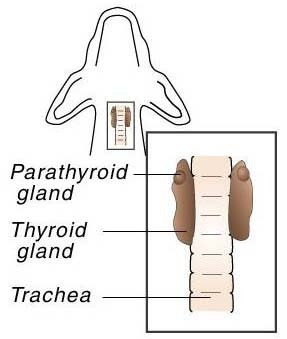OVERVIEW
Liver, kidney, heart, and thyroid diseases are serious and can be life threatening. Thyroid and endocrine conditions are difficult to manage. Make sure to get an accurate diagnosis before attempting to treat this or any condition.
The thyroid glands are located in the next on either side of the windpipe in the neck. The thyroid produces 2 iodine-containing hormones, T3 and T4, which affect many processes in the body. In general, the thyroid hormones regulate metabolic rate, or the speed at which body processes run.
Decreased thyroid hormone production, hypothyroidism, typically results in overweight and sluggish animals that always seem cold with poor coats. Hypothyroidism, an autoimmune disease, is uncommon in cats but now occurs in dogs at an increasingly rapid rate, especially over the last 30yrs. It usually occurs in dogs aged 4-10. Hypothyroidism is rarely serious by itself, but that’s not the case with hyperthyroidism.
Hyperthyroidism is an excess production of the thyroid hormones. This is uncommon in dogs but is regularly seen in cats. In the United States, the condition affects 10% of cats over 10 years of age. When this occurs the cat or dog eats ravenously, though she loses weight as the food passes rapidly through the intestines and exits as diarrhea without providing much nourishment. You’ll notice restless, hyperactive, and warm bodies and coughing from heart disease — the heart beats faster and more forcefully. With time, the left lower side of the heart compensates by becoming thicker, creating a form of hypertrophic cardiomyopathy, which eventually leads to heart failure.
TESTING
It seems total (T3) is not a very helpful test in cats because even mild cases, 80% of cats will have normal results. Serum fT4 is better test than TT4 or T3, and the results are less likely to be affected by other factors. For dogs hypothyroidism thyroxine (T4) is the primary hormone produced by the thyroid gland in response to stimulation by the pituitary gland. A ‘feedback system’ exists between the thyroid gland and the pituitary gland. When T4 concentrations in the blood are low, the pituitary sends a signal to the thyroid gland using thyroid stimulating hormone (TSH), prompting the thyroid gland to produce more T4. When T4 levels in the circulation are adequate, the pituitary decreases its production of TSH, thereby reducing the production of T4.
CAUSES
There are several theories on why so many older cats develop hyperthyroidism, but there is little hard evidence. Epidemiologic studies point to canned food as a risk factor, and one study points specifically to canned food containing liver, fish, and/or giblets [Peterson ME, Ward CR. Etiopathologic findings of hyperthyroidism in cats. Vet Clin North Am Small Anim Pract. 2007;37(4):633-645].
This condition was virtually non-existent 30yrs ago. There’s evidence that decreased kidney (CKD) function triggers compensation from the thyroid activity in an attempt improve blood flow to failing kidneys (REF 1, REF 2). In other words, CKD may trigger hyperthyroidism.
Hypothyroidism’s cause in dogs seems to be a genetic source, specifically DLA (dog leukocyte antigen), which may have a link to the amount of Omega 3 in the diet (REF). There is some speculation that vaccinations and drug use, especially ’sulfa’ drugs (i.e., heart worm medication) are the cause. Others say it’s the chlorine and fluorine in municipal water supplies — most European countries have banned fluoridation yet they still have thyroid disease occurring with their pets.
DIET
For the hypothyroid dog it’s important to supplement minerals that support thyroid function. Iodine is vital to normal thyroid function. Kelp, spirulina, and other iodine rich foods can boost function. Giving too much iodine may also be harmful which can lead to a worsening of the hypothyroidism you’re trying to address.
A link has been shown between selenium deficiency and hypothyroidism. Synthetic antioxidants used to preserve some dog foods can impair the bioavailability of selenium, along with vitamin A and E. Zinc is also critical to the function of the entire immune system playing a role in over 300 enzymatic and metabolic processes including thyroid hormones.
The Brassica family of vegetables (broccoli, cabbage, cauliflower, Brussels sprouts, turnips) contain a compound called goitrin that can naturally slow thyroid function. These should be avoided in hypothyroid dogs and cats.
For hyperthyroidism, good food is essential! This is because the better the food, the better digestion occurs, allowing the cat to have more nutrition absorbed as food flies through the digestion process due to a sped up metabolism. There’s some evidence that turmeric can help with thyroid management. Adding some of the Brassica family of plants can be helpful to slow hyperthyroidism, where these plants are to be avoided in hypothyroidism. It may be tricky to get your kitty to eat broccoli or other plants, but there are some ways to introduce it into their food more-or-less seamlessly.
We have the ability to create a diet balanced with the correct nutrients specific to your pet’s needs through our Custom Meals. Making high quality food that your pet will eat is our specialty. Even broccoli. We have a long history of designing successful hyper and hypothyroidism diets, along with other autoimmune/endocrine conditions. Contact us for details on how to get started.

In recent years, pet owners have become increasingly concerned about the quality and nutritional value of the food they feed their furry companions. One trend that has been gaining popularity is the use of hydrolyzed ...
Introduction As pet owners, we are constantly seeking ways to improve the health and well-being of our beloved furry companions. One aspect that has gained significant attention in recent years is the use of herbal ...
As we move through this holiday season and towards the new year, we’ve been stuffing our faces as we prepare to stuff our stockings! You might already be at the point where you are loosening ...